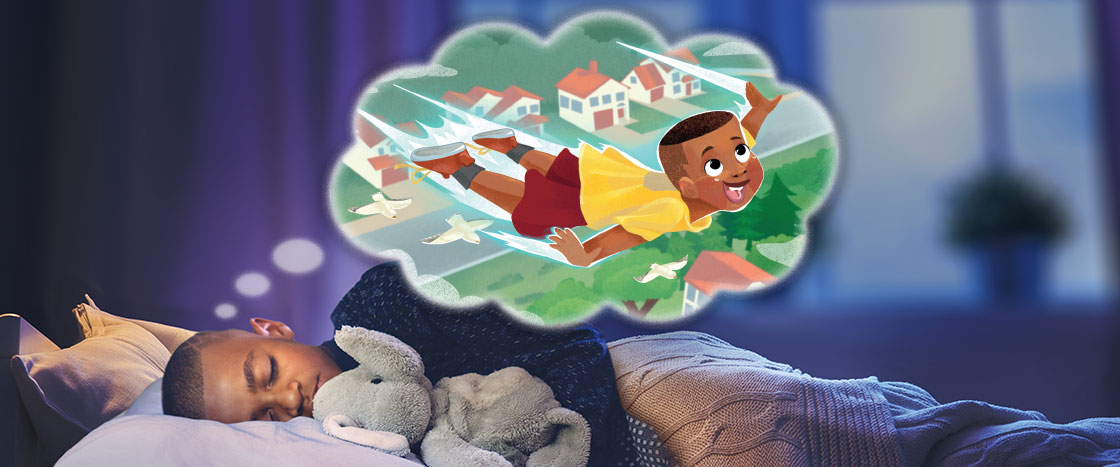Yawn! You might think sleep is boring. You might think nothing happens when you sleep. But that’s not true. Your body and brain are busy.
Yawn! Do you think nothing happens when you sleep? That is not true. Your body and brain are busy.

What really happens when you sleep?
The Secrets of Sleep
What really happens when you sleep?
Yawn! You might think sleep is boring. You might think nothing happens when you sleep. But that’s not true. Your body and brain are busy.
Yawn! Do you think nothing happens when you sleep? That is not true. Your body and brain are busy.
Busy Body
When you sleep, your body is still working. It does most of its healing at night too.
Have you ever had a cut on your knee? While you sleep, the scab gets stronger.
Sleep also helps you grow. Your sleeping brain sends out chemicals. They tell your bones to grow.
Your body is working as you sleep. It does most of its healing at night.
Have you ever had a cut on your knee? The scab gets stronger while you sleep.
Sleep helps you grow. Your sleeping brain tells your bones to grow.
Busy Brain
Your brain doesn’t turn off when you sleep. It is busy dreaming.
When you dream, you are sleeping very deeply. Your brain tells your muscles to stay still. That way, if you fly around in your dream, you won’t try to fly in bed.
But one thing keeps moving when you dream. Your eyeballs move around under your eyelids!
Your brain is busy when you sleep. It is busy dreaming.
When you dream, you are sleeping very deeply. Your brain tells your muscles to stay still.
One thing keeps moving when you dream. Your eyeballs move under your eyelids!
Ready for Bed?
Now you probably can’t wait to go to bed tonight. So much happens when you turn out the light! Zzzzz.
Now you probably can’t wait to go to sleep tonight. So much happens when you turn out the light!

Six Sleepy Animals
Owen Newman/NPL/Minden Pictures
Leopards
They fall asleep high up in trees. That keeps them safe from enemies.
Leopards
They fall asleep high up in trees.
Zoonar GmbH/Alamy Stock Photo
Flamingos
They sleep on one leg. That may help them keep warm.
Flamingos
They sleep on one leg.
Ann and Steve Toon/NPL/Minden Pictures
Meerkats
They sleep together in a pile. That keeps them warm.
Meerkats
They sleep together in a pile.
Ito Fukuo/Nature Production/Minden Pictures
Parrotfish
They make a bubble of mucus (MYOO-kuss) around themselves when they sleep. That keeps them safe from enemies.
Parrotfish
They sleep in a bubble of mucus (MYOO-kuss).
Ito Fukuo/Nature Production/Minden Pictures
Giraffes
They rest their heads on their backs. That is really comfy!
Giraffes
They rest their heads on their backs.
iStockPhoto/Getty Images
Red-eyed Tree Frogs
They have see-through eyelids. That lets them sense enemies while they sleep.
Red-eyed Tree Frogs
They have see-through eyelids.
More About the Article
Science Focus
Human body; Personal health; Animal needs
Vocabulary
scab, chemicals, muscles, mucus, sense
ESSENTIAL QUESTION
The big question of this issue of Storyworks 2 is: What surprising things happen in the dark?
1. BEFORE READING
Show “The Big Question” Video (10 minutes)
Watch “The Big Question: What Surprising Things Happen in the Dark?”
(This video also goes with other stories in this month’s Storyworks 2.)
Preview vocabulary (3-5 minutes)
Preview the Article and Set a Purpose for Reading (15 minutes)
2. READ THE PAIRED TEXTS (10 MINUTES)
3. AFTER READING
ELA Focus: Quiz (10 minutes)
ELA Focus: Key Details (20 minutes)
ELA Focus: Compare and Contrast (15 minutes)
Enrich the Learning: Paired Text Opportunities (time amount varies)
Making text-to-text connections builds knowledge and comprehension. We layer Storyworks 2 with many ways for your students to make connections.
Pairable Texts The Big Read, “A Creature in the Dark” (pages 6-11); the Fiction, “The Stars Below Me” (pages 24-29); and the Poem, “Crash! Bang! Boom!” (page 32)